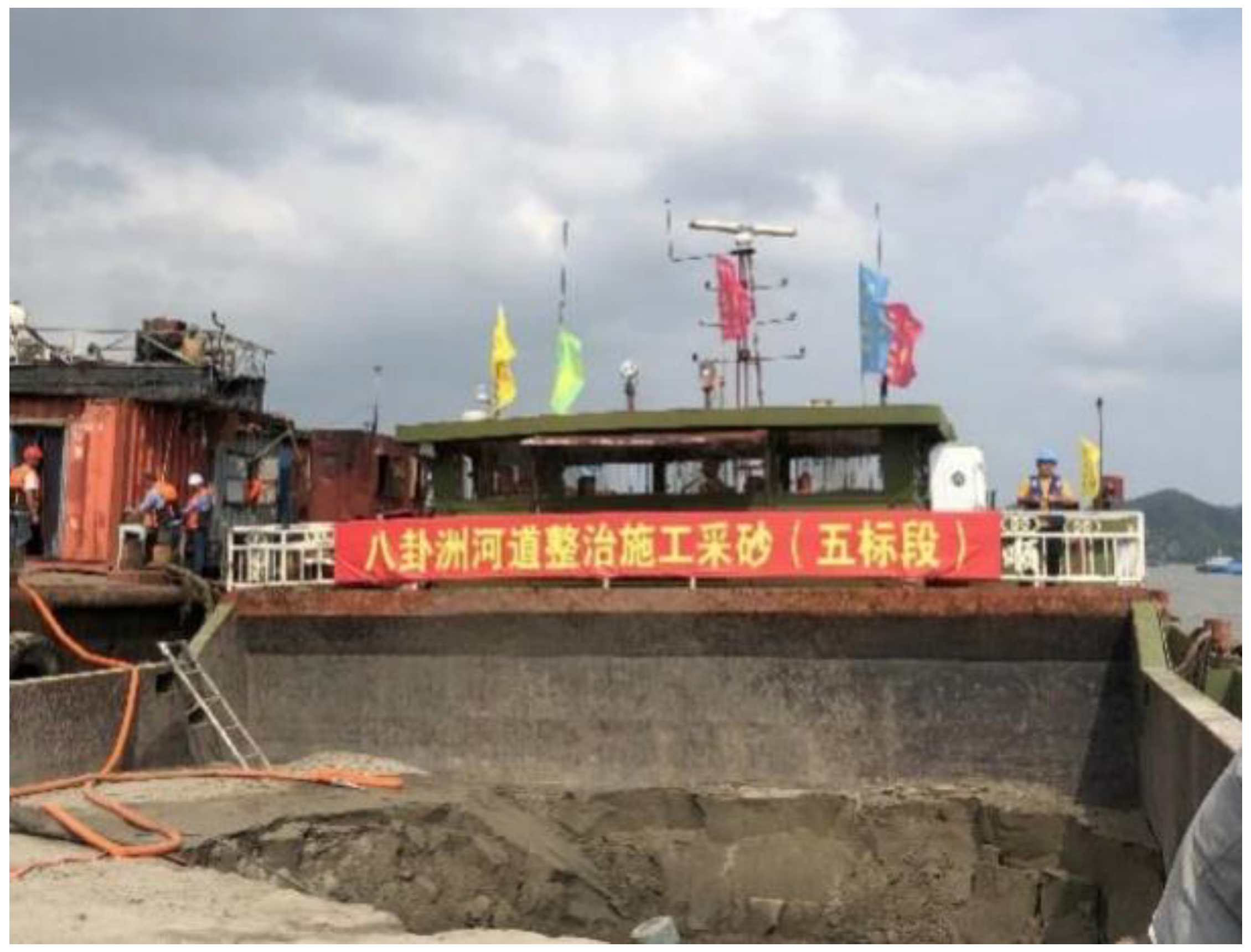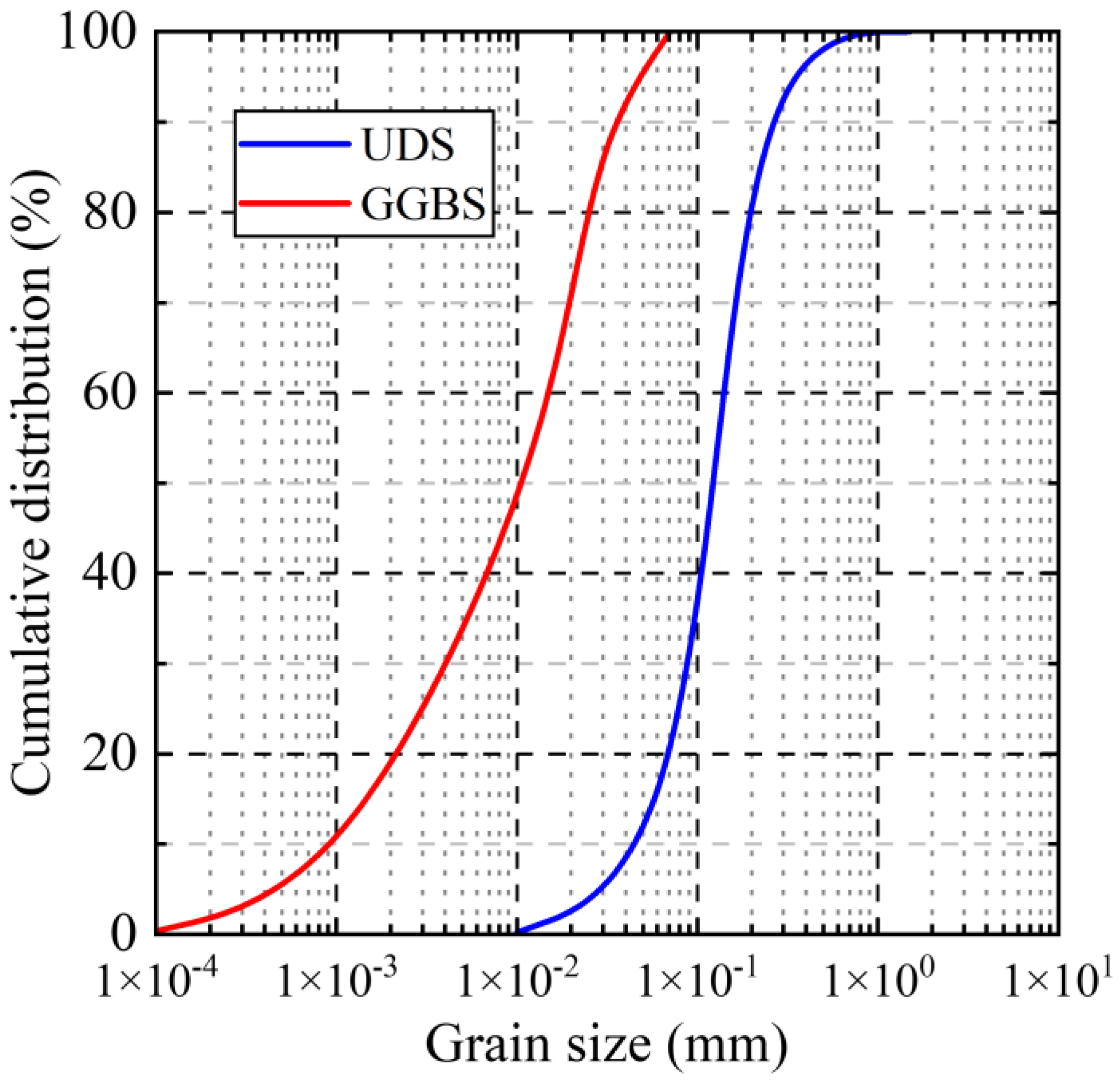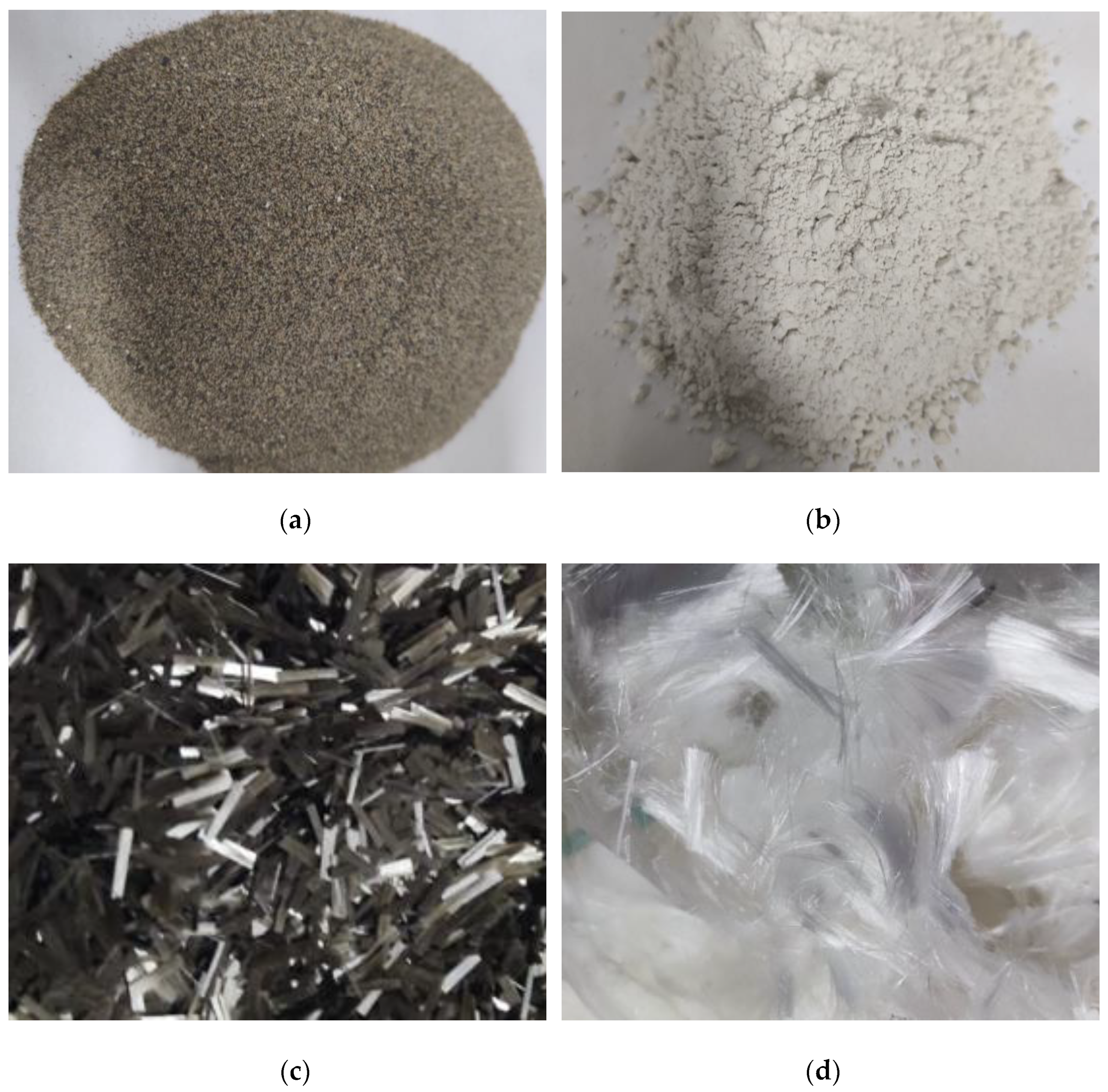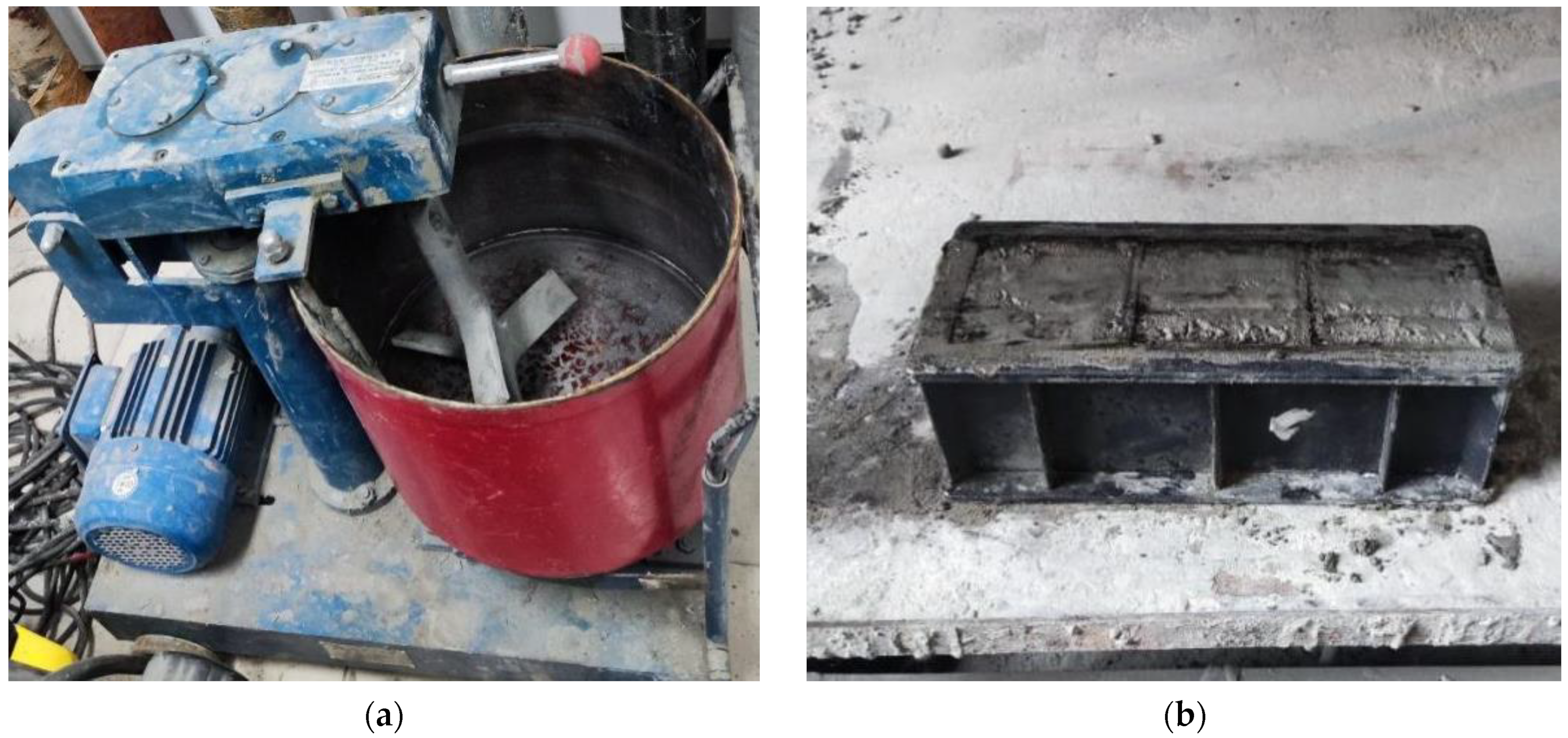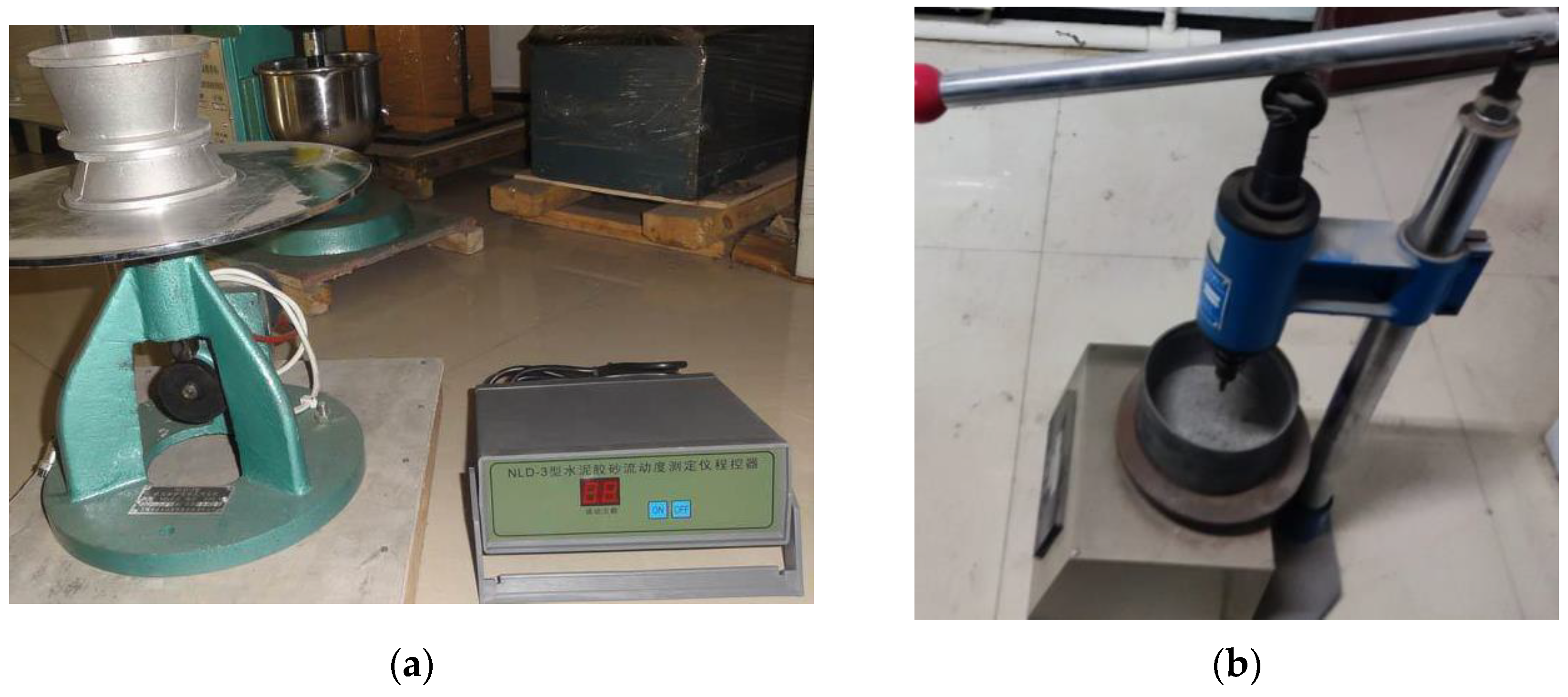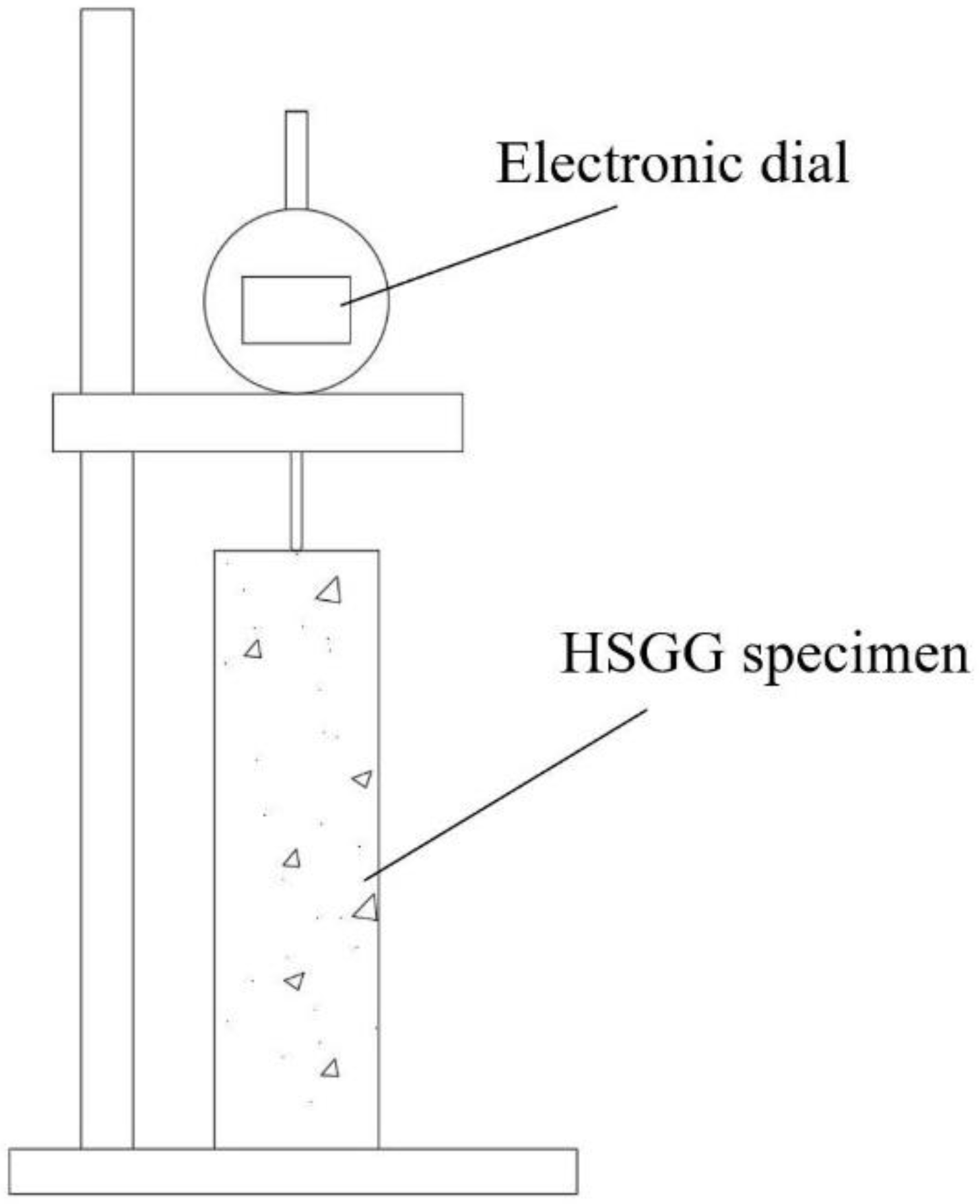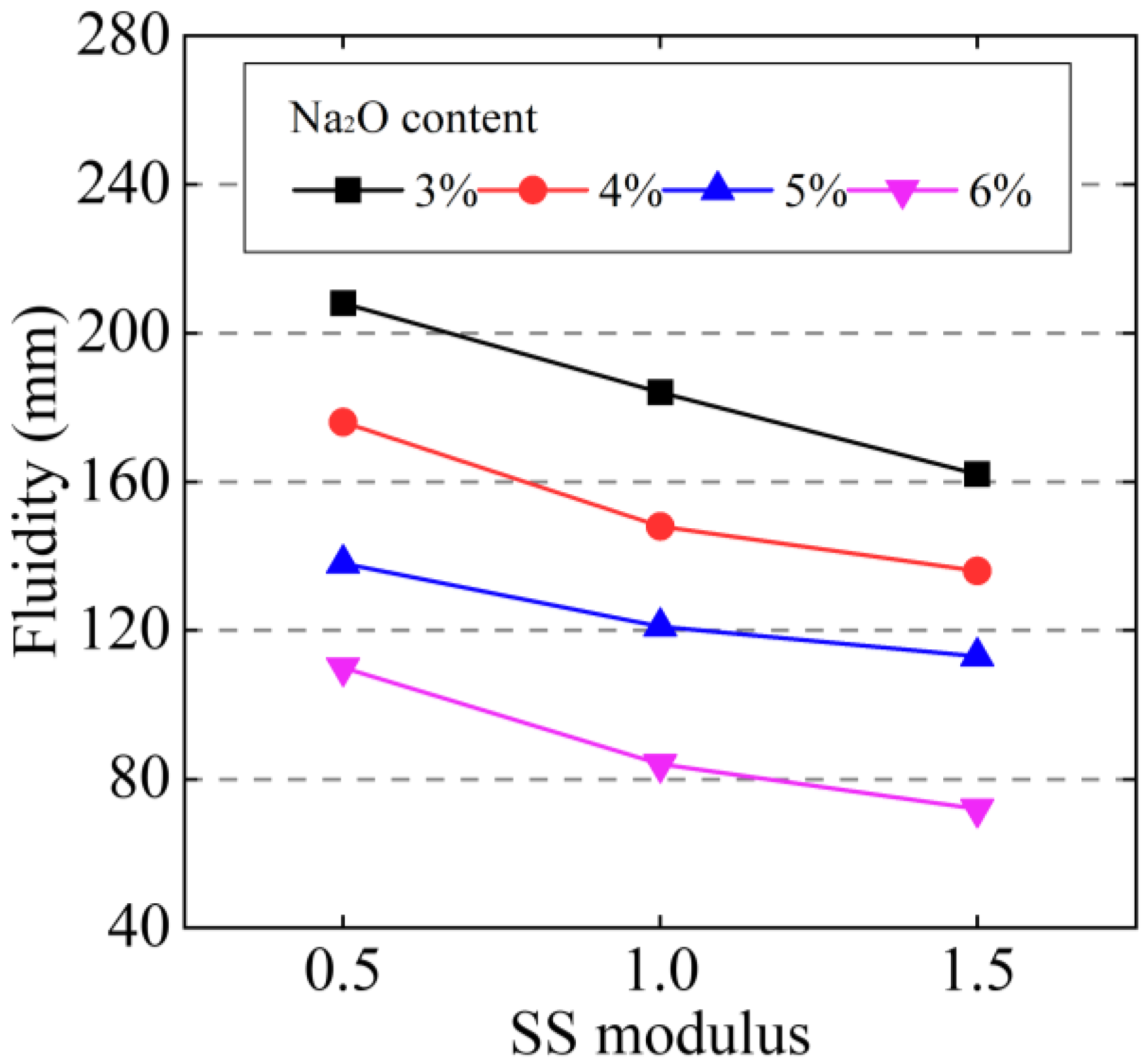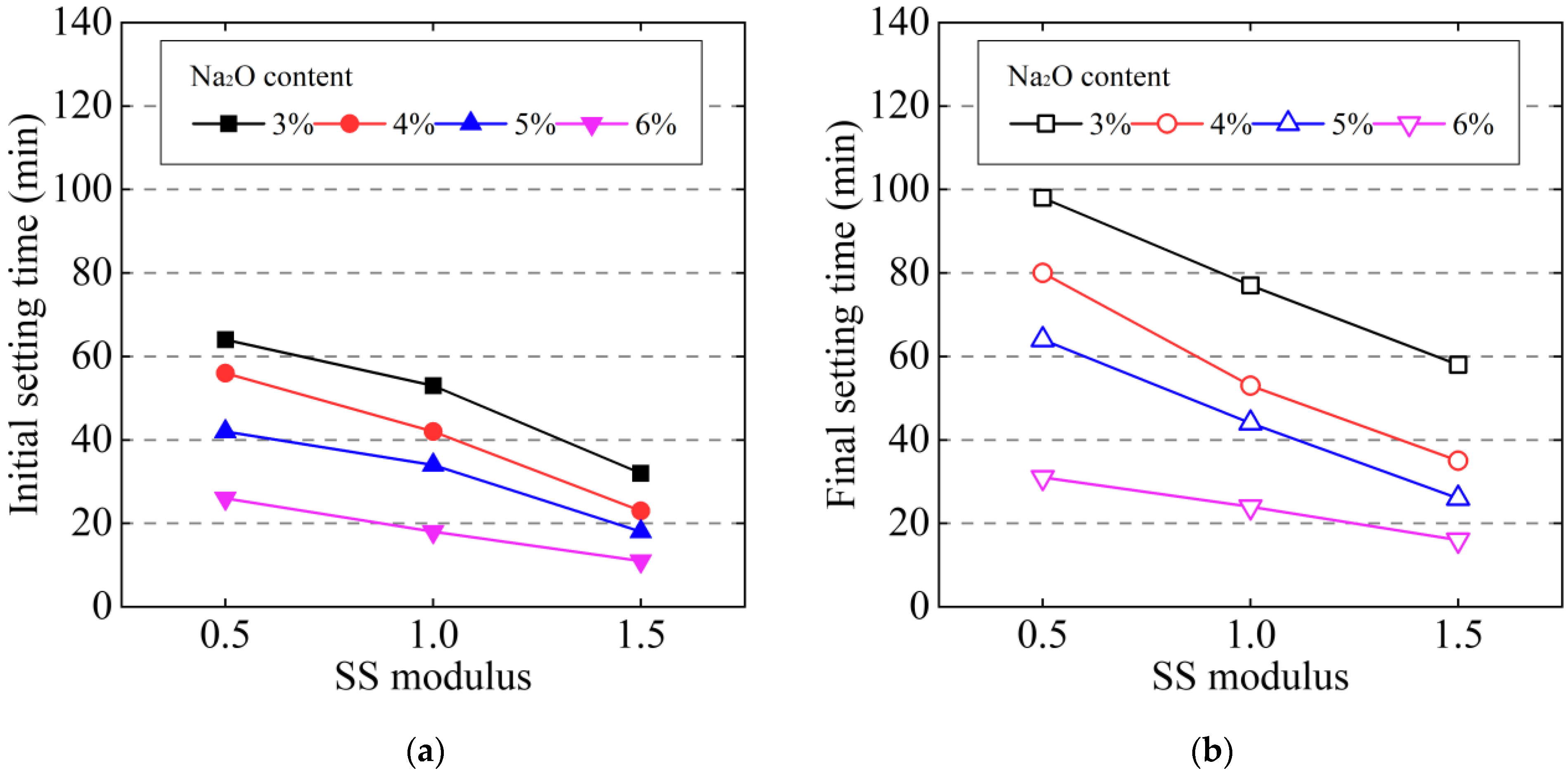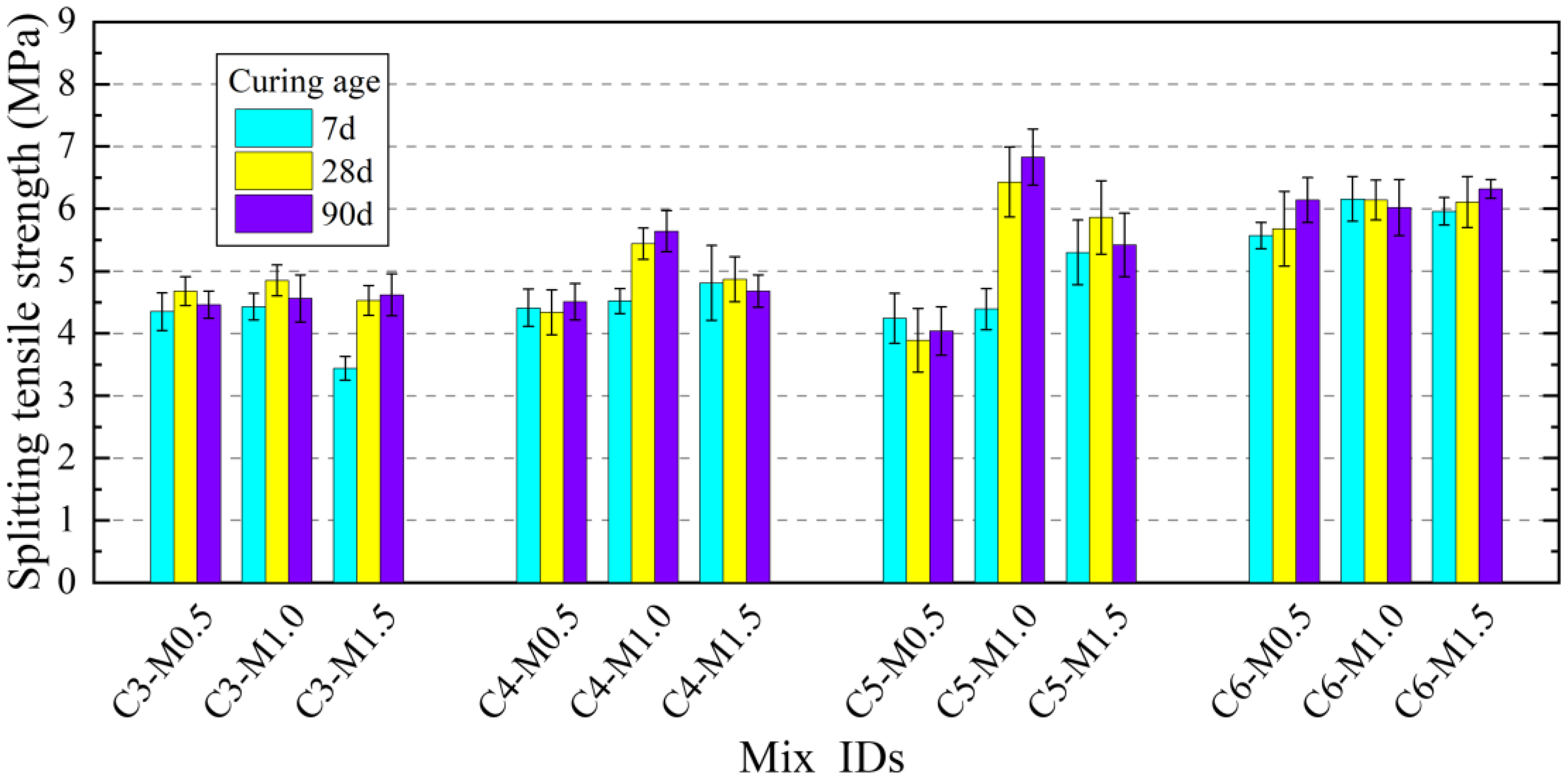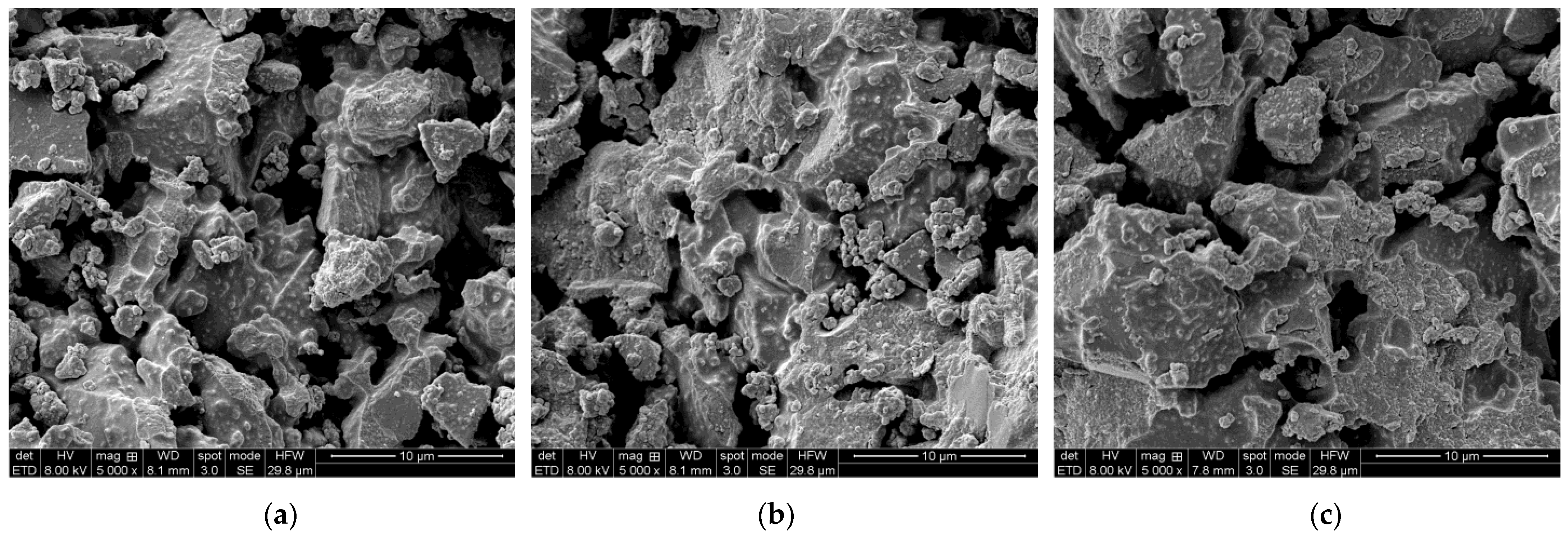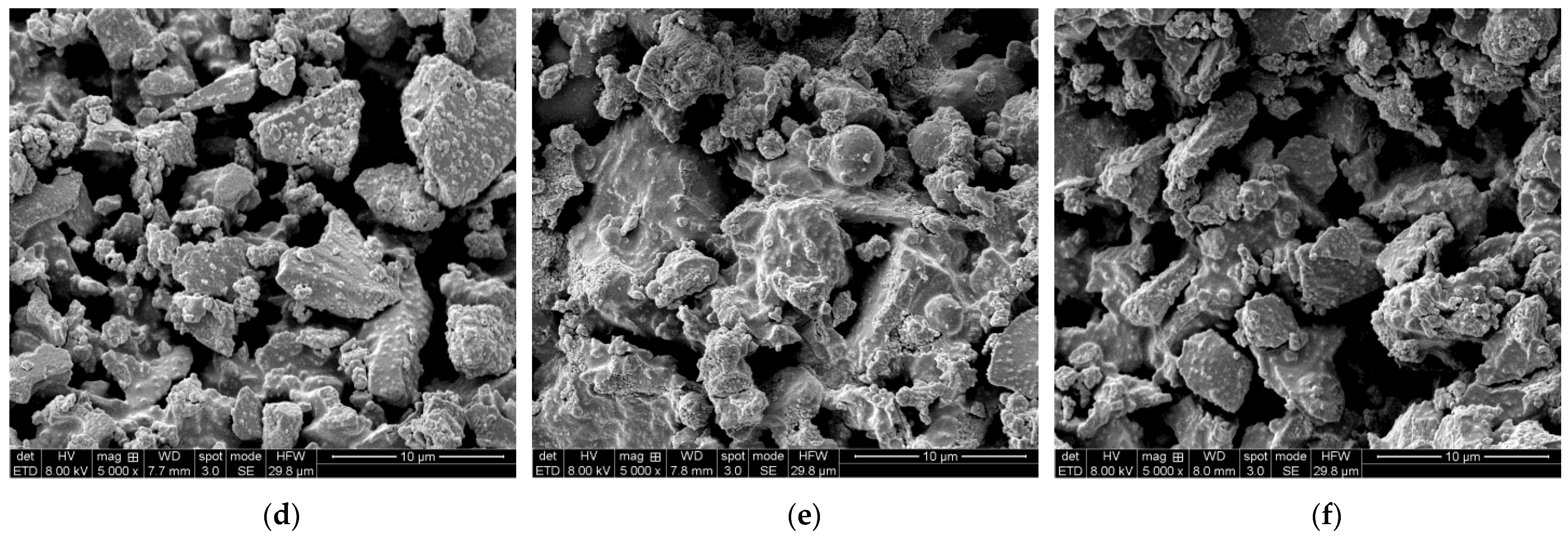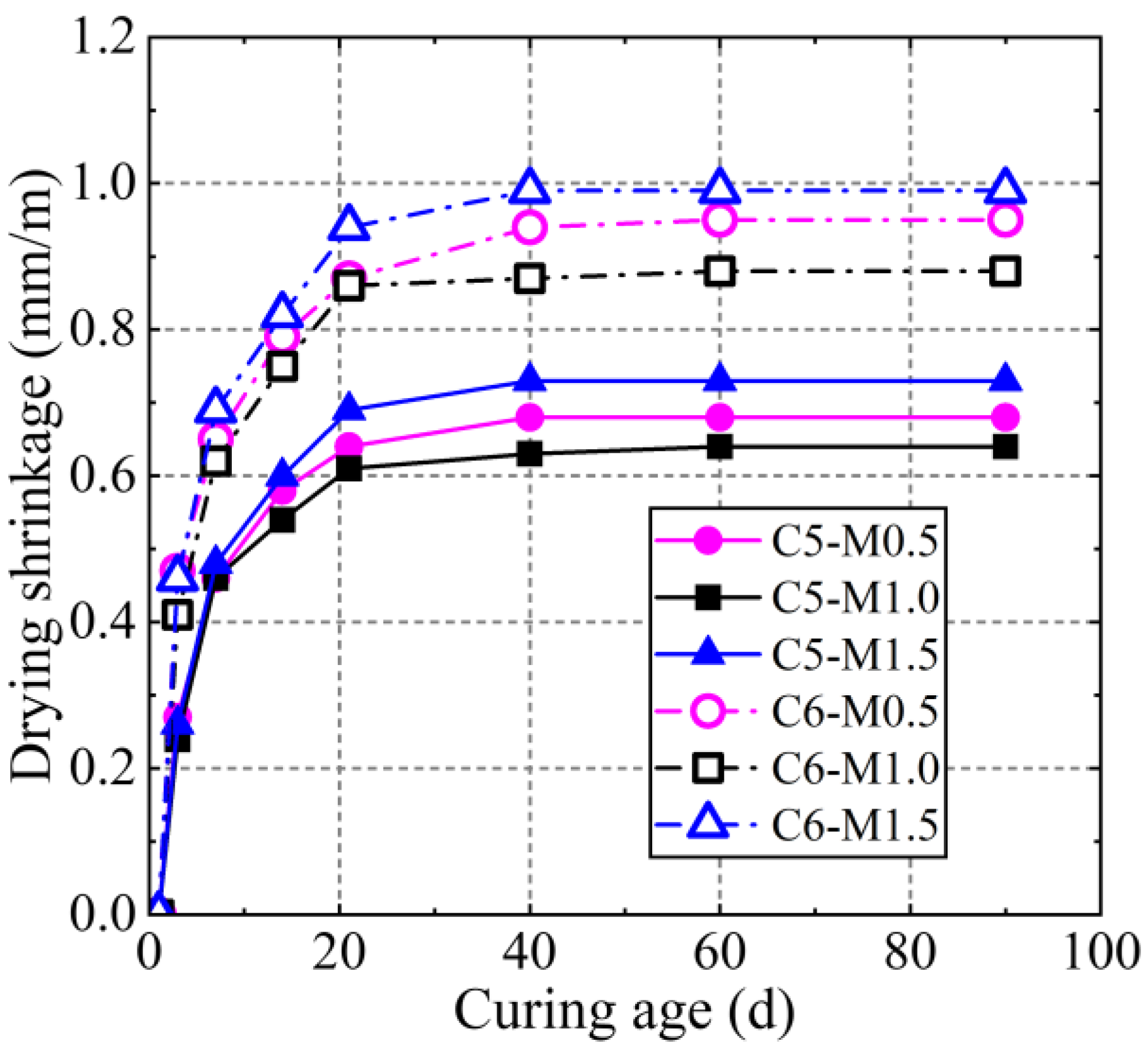1. Introduction
Waterway engineering projects, such as port construction and channel renovation, generate a significant amount of ultra-fine dredged sand (UDS), which has historically been discarded in deep-sea areas and underutilized. Improper dumping of dredged sediment will directly cause environmental pollution, especially harm to the diversity and richness of the benthic community [
1]. In recent years, China has become the world’s largest dredging country, with an annual dredging volume exceeding one billion cubic meters. The technology of UDS resource utilization is to process UDS into artificial blocks by a series of physical and chemical means to create more economical and ecological benefits in practical engineering. Meanwhile, with the increasing scarcity of sand and gravel resources, coupled with the implementation of policies prohibiting open-pit mining, UDS emerges as a promising substitute for construction materials.
Portland cement is the most widely used material in construction. Against this backdrop, some studies have confirmed that silicate concrete prepared with dredged sediments can improve performance, which fully demonstrates the great potential of dredged sand as building materials. Hassoune et al. [
2] studied the feasibility of using dredged sand from the port of Agadir in concrete formulations. Their later research showed that the formulation based on dredged sand could be applied to construct a quay wall, which was later proved stable [
3]. Vafaei et al. [
4] developed a high-strength concrete using seawater and dredged sea sand. They found that the dredged sea sand in concrete led to a considerable reduction in water absorption and sorptivity, which was consistent with what Limeira et al. [
5] had previously discovered. Loudini et al. [
6] evaluated the short-term and long-term mechanical behaviors of the silicate concrete based on dredged sediments, and the formulation worked out could be used in road foundation construction. However, dredged sediments from different rivers vary significantly in texture and characteristics. This mainly depends on the geological structure of the river, hydrological conditions, discharge, and sediment content. For example, mountainous rivers are often washed by rain, so the dredged sand particles are mostly stone sand, coarse particles with good mechanical strength and anti-erosion performance. In contrast, the UDS samples studied in this paper are from the plain area of the lower reaches of the Yangtze River. Due to the different hydrological conditions, the UDS has a finer texture and extremely small particles. The particles have a fineness modulus of 0.1–0.5 and a particle size of 0.075–0.3 mm. The particle surface of UDS is smooth, and there are problems such as irregular particles, much clay and lightweight. It is difficult for UDS to fully combine with Portland cement, resulting in mortar segregation. In the preliminary test, it was observed that the slurry containing UDS, which was directly solidified using Portland cement, exhibited poor quality and unstable strength in later stages. We have to explore other ways to utilize the UDS resources.
Geopolymer, a synthetic material formed by the reaction of aluminosilicate sources with alkaline hydroxide or silicate solutions, is a new environment-friendly material that can replace Portland cement [
7,
8]. Geopolymer has the advantages of fire resistance, high early strength, chemical corrosion resistance, and excellent durability, which brings broad application prospects in high-strength materials [
7,
9]. The construction industry faces the challenges of depleting fossil fuel reserves, scarcity of raw materials, increasing demand, growing environmental problems and a stagnant world economy. It is worth mentioning that producing 1 ton of Portland cement emits over 1 ton of CO
2, including both direct chemical reaction emissions and additional emissions from fuel combustion [
10]. The cement industry is responsible for about 5–7% of the world’s CO
2 emissions in the current scenario. The use of low-carbon geopolymer as a substitute for ordinary cement in solidifying dredged sand and further processing it into protective bricks, load-bearing blocks, and other artificial structures in the fields of ports and water conservancy can effectively solve the problems of dredged sand accumulation and landfilling, and realize the high value-added utilization of waste dredged sand. At the same time, the effective use of geopolymer reduces the amount of cement used, and thereby reduces the carbon emissions and energy consumption in the production and transportation of cement.
Some researchers have investigated the solidification of dredged materials with geopolymer. Anbarasan et al. [
11] used dredged marine sand as a suitable replacement for the scarce river sand in geopolymer concrete production due to its corrosion resistance, resistance to carbonation, and alkalinity properties. Slimanou et al. [
12] used metakaolin to solidify the dredged sediment waste of Bejaia port, and the highest compressive strength was 22 MPa when the content of calcined dredged sediment was 15 wt%. Lirer et al. [
13] combined dredged sand with fly ash to prepare a geopolymer matrix with certain mechanical properties. The microstructure of the composite based on dredged sand was denser than that of ordinary siliceous sand. Hosseini et al. [
14] used mechanochemical treatment of dredged clay to prepare a geopolymer mortar where inert clay can replace 50% of precursor mass. Zhang et al. [
15] used fly ash-slag cementitious materials and recycled glass fiber reinforced plastic fibers to solidify dredged sludge, and it was observed that the post-rupture ductility of stabilized dredged sludge significantly increased with the increase in fiber content. The above studies indicate that geopolymer can be injected into dredged materials and form a three-dimensional network structure due to its high viscosity and adhesion properties. Upon contact with water, geopolymer rapidly absorbs water and swells, forming a gel that creates high-strength bonding and cohesive forces between dredged sand particles. These forces can effectively solidify the dredged sand and prevent it from settling or slumping. Compared to Portland cement, geopolymer can solidify dredged sand and improve its mechanical performance and stability, which is not limited by the properties of the original dredged sand. Moreover, the alkali-activated system in geopolymer can easily produce significant drying shrinkage, which will cause non-uniform deformation and detrimental cracks [
16,
17,
18,
19,
20]. UDS contains a significant amount of small particles and smooth surfaces, which can affect the bonding strength between geopolymer and sand particles, leading to reduced adhesive force, higher water absorption, and exacerbation of drying shrinkage. The harmful shrinkage cracks can create channels for various corrosive substances to penetrate the composite material, severely affecting the load-bearing capacity and durability [
16].
Currently, potential fiber additives and the adjustment of alkali molar ratios are commonly used methods to enhance the mechanical performance and stability of geopolymer materials. However, for geopolymer-based solidification of UDS, the specific effects and optimal combinations of these factors, as well as their influence on the microstructure and shrinkage mechanism, have not been thoroughly investigated. In this study, by utilizing ground granulated blast-furnace slag (GGBS), UDS, sodium silicate (SS), and sodium hydroxide (SH), we developed a brand-new hybrid UDS-GGBS geopolymer (HUGG) paste. The experimental scheme was meticulously designed to clarify the influences of SS modulus and Na2O content on the fluidity, setting time, mechanical properties, and shrinkage behavior of the HUGG paste. The microstructure was analyzed in detail by scanning electron microscope (SEM). Additionally, basalt and polypropylene fibers (BF and PPF) were employed to offset the linear drying shrinkage. This study aims to ensure that the HUGG concrete’s mechanical properties and drying shrinkage conform to the engineering standards while simultaneously offering environmental and economic benefits. The blocks prepared from UDS should possess sufficient strength and the linear shrinkage rate during the drying process should be controlled within an acceptable range to avoid excessive stress. Fibers can be added to control cracks and prevent the expansion and damage caused by drying shrinkage. The HUGG paste utilizes abandoned UDS as raw material and transforms it into high-quality material suitable for concrete production. This reduces the demand for natural sand and preserves natural resources while also mitigating the carbon emissions associated with not using conventional cement, resulting in significant environmental benefits. The developed HUGG concrete can be a viable alternative to conventional concrete for producing small prefabricated units such as road paving blocks and interlocking pavers, which can be used in local applications for canal rehabilitation, road and municipal engineering projects.
3. Results and Discussion
3.1. Fluidity
The fluidity test results of HUGG pastes are presented in
Figure 8. The fluidity of the slurry exhibits a reduction upon incrementing the Na
2O content and SS modulus. When the Na
2O content is 3%, the diffusion diameter of the slurry consistently exceeds 160 mm. With a content of 5%, the diffusion diameter is approximately 120 mm. However, when the Na
2O content increases from 5% to 6%, the diffusion diameter significantly decreases to around 80 mm, which severely impacts the operational performance of the slurry. The main reason is that the incremental alkali concentration in the reaction system accelerates the progress of the polycondensation reaction and quickly makes the slurry viscous. When the SS modulus increases, the high concentration of free silicon-oxygen (Si-O) tetrahedral groups promptly reacts with the dissolved calcium in GGBS to produce sufficient C-S-H gel, resulting in a drastic reduction in fluidity [
24]. An excess of activation agent can accelerate the hydration reaction of geopolymer, resulting in the formation of a large amount of gelling substance and leading to a decrease in the fluidity of the concrete.
The shape and size distribution of particles in UDS and GGBS have a significant influence on the fluidity of geopolymer. These raw materials typically contain small and irregular particles, leading to the development of cohesive and frictional forces that can reduce the fluidity of geopolymer. The presence of charges on the surface of particles in raw materials often leads to the formation of particle aggregates and precipitation through ion interactions, which can ultimately reduce the fluidity of the geopolymer. The fluidity and workability of fresh geopolymer paste are typically lower than those of conventional silicate concrete, owing to its inherent viscous and cohesive nature [
25]. In this study, the HUGG paste can achieve compaction with vibrators even at low fluidity values.
3.2. Setting Time
Figure 9 shows the setting time test results of the HUGG pastes. The final setting times of different composition schemes are all less than 100 min. The slurry’s initial and final setting times are negatively correlated with the Na
2O content and SS modulus. The increased alkali and soluble SiO
2 have accelerated the polymerization processes to a large extent. When the modulus is 1.0 and the Na
2O content is 5%, the initial and final setting time are 33 and 44 min, respectively. When the modulus is 1.0 and the Na
2O content is 6%, the initial and final setting time are 18 and 26 min, respectively. An increase in Na
2O content from 5% to 6% can result in a decrease of 45.46% and 40.9% in the initial and final setting time of the slurry, respectively. A flash-setting phenomenon was observed in the experimental group with a Na
2O content of 6%, as evidenced by the similarity of the initial and final setting times. Such a phenomenon is commonly associated with an excessively rapid hydration reaction rate, which can be attributed to inadequate mix design, subpar raw materials, or elevated Na
2O levels. Geopolymer’s flash-setting can result in wasted resources and amplified production costs, as well as have detrimental effects on the mechanical properties of concrete structures, thereby posing a threat to the safety of construction projects.
The degree of condensation of geopolymer slurry can be related to the content of available calcium [
10]. Free calcium ions dissolved from GGBS react with silicates to form C-S-H gel. C-S-H gel has a more open and porous structure that allows greater alkali/water diffusion through the gel, resulting in more gel formation and shorter setting time [
10]. A sufficient amount of calcium can dramatically increase the early compressive strength of GGBS-based geopolymer but simultaneously reduce both the initial and final setting times [
26]. The GGBS itself is more reactive, and its fine particles provide more reaction interfaces, increasing the contact area between the reactants and the solution, thereby accelerating the reaction rate. Before the geopolymer setting process begins, it is necessary to mix the mixture thoroughly to ensure consistent distribution of the UDS throughout the motor.
3.3. Influence of Na2O Content on Mechanical Properties
The mechanical properties of different mix designs were examined at various test ages, and the results are presented in
Figure 10 and
Figure 11. When the Na
2O content is below 4%, insufficient concentration of the activator can lead to a decrease in reaction rate, resulting in incomplete polymerization. This leads to an inadequate number and length of polymer chains, causing a reduction in cross-linking capability and subsequently lowering the strength of the geopolymer. A significant portion of the unreacted or partially reacted monomers may only serve as fillers or aggregates in the structure, contributing minimally to the overall strength of the geopolymer. It was found that Mix C5-M1.0 achieved the highest compressive and splitting tensile strengths of 56.53 MPa and 6.83 MPa, respectively, at 90 days. As the Na
2O content increased, both compressive and splitting tensile strengths generally increased with age. The compound SS-SH activator plays a dual role in alkali activation for preparing mortar. At a macroscopic level, the presence of Na
2O provides the necessary hydroxide environment for cementitious material reactions [
17]. The degree of GGBS hydration is closely related to hydroxide concentration. Additionally, liquid SS provides various Si-O tetrahedral groups with different degrees of polymerization during the reaction. Adequate quantities of silicate and aluminate monomers are produced to facilitate the formation of a three-dimensional mesh with silicate and aluminate gel, thereby improving the mechanical properties [
27].
However, it is important to note that increasing the concentration of alkali solutions does not always result in higher mechanical properties. For instance, when the SS modulus is kept constant at 1.0, and the Na2O content increases from 5% to 6%, the compressive and splitting tensile strengths at seven days increase by 18.7% and 63.1%, respectively, while those at 90 days decrease by 8.5% and 11.9%, respectively. This is because an increased Na2O content accelerates the hydrolysis and condensation hardening of the cementitious materials, leading to a significant decrease in setting time. During this flash-setting period, it was observed that some raw materials were only partially dissolved while the condensation hardening process had already occurred or even completed, thereby increasing the porosity and deteriorating the mechanical properties in the later stages.
3.4. Influence of SS Modulus on Mechanical Properties
The compressive and splitting tensile strength of all mix designs almost reach their peak values when the SS modulus is 1.0. SS modulus has a greater influence on the splitting tensile strength of geopolymer compared to its compressive strength. When the Na
2O content is kept at 5%, an increase in modulus from 0.5 to 1.0 results in a 65.3% improvement in splitting tensile strength. Normally, an increased SS modulus provides more Si-O tetrahedral molecules with varying degrees of polymerization, which can facilitate the precipitation and polymerization of dissolved species [
28]. Appropriate modulus can enhance the micro-network structure of geopolymer, providing it with higher splitting tensile strength.
When the Na
2O content is 4% or 5%, the compressive and splitting tensile strength with a modulus of 1.5 are lower than those with a modulus of 1.0. The high-modulus SS solutions often contain Si-O tetrahedral groups that are highly polymerized, leading to a propensity for self-polymerization, which in turn increases the solution’s viscosity and diminishes its workability [
7]. When high-modulus SS reacts with cementitious materials, it may generate sodium silicate gel containing sodium ions, which can cause cracks and looseness during the hardening process of geopolymers, ultimately reducing their mechanical properties and service life.
3.5. Microstructural Analysis
The HUGG specimens were subjected to SEM analysis to examine the particle morphology of hydration products after mechanical testing. The micrographs of the high-strength specimens at 28 days are presented in
Figure 12. When the content of Na
2O is low, the geopolymer exhibits weaker gelation due to a lower degree of hardening, while with an increase, the gelation degree of geopolymer increases, leading to a denser gel network and improved mechanical properties. When the content of Na
2O is 5%, the formed geopolymer bonding structure is relatively dense (
Figure 12a–c). The preparation of geopolymer is achieved through the reaction between aluminosilicate and alkaline activator. At the beginning of the reaction, hydroxide ions (OH
−) in the activator react with the metal-oxygen bonds in the aluminosilicate framework, forming Si-O and Al-O bonds. At this point, the pH value in the system gradually increases, accelerating the hydrolysis reaction and generating more Si-O and Al-O bonds, thereby increasing the network density of the polymer. When the network density of the polymer exceeds a certain limit, excessive polymerization occurs, resulting in the formation of a large number of cross-linking structures.
Regarding the condensation process, the preparation of geopolymer requires a certain amount of time to allow for sufficient polymerization and the formation of a network structure. If the condensation time is insufficient, the polymer will exhibit incomplete polymerization. Flash-setting can cause a significant number of voids and cracks inside the geopolymer, and these defects can gradually expand during use, leading to instability and a shortened service life of the geopolymer. When Na
2O content increased from 5% to 6%, excessive Na
2O content can lead to flash-setting, causing the fracturing and looseness of the geopolymer matrix (
Figure 12d–f). An excessive concentration of activator accelerates the progress of the polymerization reaction, leading to an increased rate of polymer chain formation during the curing process of geopolymer. This results in faster formation of the polymer network and cross-linking reactions, leading to greater shrinkage stress during the drying process. Moreover, a high concentration of activator can cause faster moisture loss from the geopolymer. Moisture plays a crucial role in the polymer curing process, and its evaporation and loss contribute to the volume shrinkage of the geopolymer. If the moisture loss rate is too rapid, the drying process will exhibit more pronounced shrinkage. In the case of UDS, the particles have a very small size, resulting in a high specific surface area. Due to the larger surface area, the polymer comes into contact with the surrounding environment more extensively, facilitating the evaporation of moisture. This accelerates the drying process of the polymer, leading to an intensified shrinkage phenomenon. The above reasons provide a detailed explanation for the formation of shrinkage cracks and pores within the matrix.
The presence of calcium in GGBS promotes the formation of amorphous C-S-H gel as the dominant hydration product when stimulated by SH and SS [
29]. On the other hand, the reaction of aluminosilicate raw materials with high alkaline activators in geopolymers results in the dissolution and release of free [SiO
4]
− and [AlO
4]
− tetrahedral units, allowing the formation of a unique three-dimensional oxide network structure with Si-O-Al-O bonds [
30]. Unlike Portland cement, which tends to produce weak interfacial adhesion with aggregate due to the enrichment of calcium hydroxide, geopolymer productions primarily form a three-dimensional network gel with covalent bonds that can closely combine with the aggregate to form a stable structure [
7,
31]. However, high concentrations of hydroxide may hinder the formation of C-S-H gel unless a substantial amount of calcium is provided, which can be effectively avoided by high-calcium GGBS in this study [
29]. These cementitious matrices and stable structures formed by the hydration reaction products are crucial for the long-term development of mechanical properties.
By conducting comprehensive research on different formulations of the HUGG paste, we have explored their fluidity, setting time, mechanical strength, and microstructure. Our results indicate that the C5-M1.0 composition exhibits the most superior comprehensive performance among various formulations. The microstructure formed in this composition is highly dense, which endows the geopolymer with outstanding mechanical strength. Moreover, the C5-M1.0 composition can meet the requirements for fluidity and setting time in practical engineering applications, demonstrating high practicability and reliability.
3.6. Drying Shrinkage Compensation
Drying shrinkage, an inherent characteristic of cementitious materials, generally refers to the volume reduction in mortar under constant temperature curing [
22]. In this study, samples with higher mechanical strengths are chosen for the drying shrinkage test, and the relationship between shrinkage values and curing ages is plotted in
Figure 13. The test results show that the drying shrinkage value ranged from 0.65 mm/m to 1.10 mm/m. The drying shrinkage development of the HUGG paste can be categorized into three stages: acceleration (1–7 days), deceleration (7–21 days), and stabilization (21–90 days). The specimens with 5% Na
2O content exhibit lower contraction and better work performance. This is mainly due to the excessive alkali dosage in the activators when the Na
2O content increases to 6%, resulting in the slurry’s quick-setting and the formation of capillary pores or cracks. Consequently, the specimens lose water continuously due to the imbalance between the initial humidity of the material and the external environment, resulting in a significant increase in linear drying shrinkage value.
To compensate for the drying shrinkage, BF and PPF were added to the mortar with varying proportions of 0.1%, 0.2%, and 0.3% of the mortar volume, using C5-M1.0 as the control group. The relevant test results are depicted in
Figure 14.
Table 4 shows the mechanical properties and 90-day density test outcomes. The control group exhibits a stable shrinkage value, which eventually reaches 0.65 mm/m. The addition of BF shows a direct proportionality with mechanical properties and 90-day density. In contrast, an increase in PPF content has a slightly positive effect on the early strength of the block, but it has a detrimental impact on the long-term development of compressive strength. The compressive strength decreases more seriously and even shrinks as the PPF content increases. The incorporation of PPF at levels of 0.2% and 0.3% can result in varying degrees of density reduction in the HUGG paste.
From
Figure 14a, by adding 0.1%, 0.2%, and 0.3% of BF to the HUGG paste, the shrinkage values at 90 days were reduced to 0.54, 0.45, and 0.42 mm/m, respectively. BF mainly consists of SiO
2 and CaO as its main chemical components. The improved mechanical properties of HUGG paste are attributed to the increased calcium content in the system, which promotes the formation of additional C-S-H and C-A-S-H gel [
32,
33]. These additional products coexist with the N-A-S-H gel, resulting in the formation of a hybrid C-N-A-S-H gel [
18]. Moreover, BF plays the micro aggregate role and increases the contact area between the UDS and GGBS in the reaction system due to good hydrophilicity. The three-dimensional disordered distribution of BF in the system can block the pores and transfer the stress, making the microstructure more compact and denser [
30]. In summary, the unique structure and chemical properties of the surface of BF allow for interaction with geopolymer and UDS, thus forming a strong interfacial bond. This interfacial compatibility enhances the adhesive strength between geopolymer and UDS, increasing the synergistic effect between them and further reducing shrinkage. Previous studies have suggested that even a small amount of PPF (0.1% volume) can significantly improve the drying shrinkage of geopolymer concretes [
18]. In our study, the addition of 0.1% PPF reduced the shrinkage value to 0.36 mm/m (
Figure 14b). Two reasons may explain the deterioration of compressive strength. Firstly, the uneven dispersion of PPF in the system and excessive fiber content can cause fiber agglomeration, leading to weak areas inside the block and ultimately reducing its compressive strength [
18]. Secondly, the hydrophobic nature of PPF results in poor contact between substrates, leading to the entrainment of air and a decrease in compressive strength [
34]. In an ordinary way, the tensile properties of concretes can be improved with appropriate additions of PPF [
35]. This study shows a slight modification effect of PPF on the early splitting tensile strength. However, as the moisture evaporates in the later stages, the problematic contact between UDS and PPF deteriorates the pore structure, leading to little modification effect on the splitting tensile strength.
In compliance with the GB/T 8239-2014 stipulations, masonry blocks are classified into two categories: L-type blocks for load-bearing structures and N-type blocks for non-load-bearing structures, based on the stress they undergo during use. The allowable maximum linear drying shrinkage value for L-type blocks is set at 0.45 mm/m, while for N-type blocks, it is 0.65 mm/m. Considering the toughening effect of different fibers and their dosages on HUGG pastes, the optimal fiber content of BF and PPF should be 0.2% and 0.1%, respectively, to satisfy the engineering requirements of L-type blocks. These optimal dosages were selected based on the experimental results, which indicate that these levels of fiber content can effectively compensate for the drying shrinkage of HUGG paste while maintaining adequate compressive and splitting tensile strength. It is worth mentioning that BF is an eco-friendly, natural, and inexpensive inorganic fiber that has exceptional properties such as high strength, excellent stability, good chemical resistance, and high-temperature resistance. PPF, on the other hand, has shown little improvement in compressive strength and a slight improvement in early splitting tensile strength. This study recommends C5-M1.0 with 0.2%BF as the optimal solution, significantly impacting long-term mechanical performance development.
4. Conclusions
This study explored the influences of SS modulus and Na2O content on the fresh properties and microstructure of HUGG paste made with UDS and GGBS. BF and PPF were used for drying shrinkage compensation in the optimal scheme. This study highlights the challenges of using UDS in geopolymer production due to its smooth surface, small particle size, and propensity for drying shrinkage. The main findings of the results can be concluded as follows:
- (1)
The fluidity and setting times of HUGG paste decrease with an increase in Na2O content and SS modulus due to the acceleration of the polycondensation reaction. Fresh geopolymer paste has lower fluidity and workability than conventional silicate concrete, but HUGG paste can still be compacted with vibrators at low fluidity values. Flash-setting can occur with elevated 6% Na2O content, which can lead to the loss of plasticity, decrease in strength, and reduction in durability.
- (2)
As the Na2O content increases, there is a significant improvement in the mechanical properties of all specimens. The optimal Na2O content of 5% is recommended to achieve maximum compressive strength and ensure the reliable performance of the slurry. Besides Na2O content, the SS modulus is the second most influential factor affecting the mechanical properties of the HUGG paste. A suitable amount of Si-O tetrahedron groups can facilitate the polycondensation reaction of raw materials, while excessive polymerization can impede the depolymerization and polymerization processes of the material. At the maximum level, the HUGG concrete exhibits a compressive strength and splitting tensile strength of 56.53 MPa and 6.83 MPa, respectively, after 90 days of curing, with the optimal conditions of 5% Na2O content and SS modulus of 1.0.
- (3)
SEM analysis of HUGG specimens showed that an increase in Na2O content resulted in a denser gel network and improved mechanical properties. However, excessive Na2O content can cause flash-setting, leading to the fracturing and looseness of the geopolymer matrix. The formation of voids and cracks due to incomplete polymerization can result in instability and a shortened service life of the geopolymer.
- (4)
The partial addition of BF can lower the shrinkage of HUGG pastes owing to its good hydrophilicity and also reinforce mechanical strengths. Considering the compensation effects and certain economic factors, 0.2% of the volume fraction of the paste is a suitable proportion. The 0.1% PPF can significantly inhibit the drying shrinkage, but the increasing volume percentage deteriorates the development of long-term mechanical properties.
This study shows that waste-dredged sand from the Yangtze River and GGBS-based geopolymer can be used to make artificial blocks that meet engineering requirements by adjusting alkali activators and adding fibers. As such, this approach presents a high value-added utilization approach for waste-dredged sand. This research holds significant potential for reducing the dependence on Portland cement, mitigating carbon emissions, and protecting the river environment.
HUGG is a complex material, and its performance is influenced by factors such as raw material composition, mix design, and preparation techniques. Due to variations in the source of materials, particularly the dredged sediments, conducting the same experiment in different laboratories or at different times may yield different results. Additionally, the experimental duration in this study was relatively short, which may not accurately simulate the long-term behavior of HUGG under sustained loading conditions. Therefore, the test results might not capture the behavior of HUGG in the long term. While the impact of a single fiber on the contraction behavior of HUGG paste has been briefly explored, further investigation is necessary to comprehensively assess the long-term durability, corrosion resistance, and carbonization effects of mixed fibers when blended with HUGG paste. Future research on HUGG can focus on studying its long-term behavior, exploring the impact of different source materials, and conducting field-scale studies. These areas of investigation would provide valuable insights into the durability, performance, and real-world applicability of HUGG.
